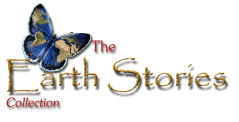Meibang Meiliu, the Mother Butterfly
Miao People – China, Vietnam, Laos and Thailand
However, the umbilical cord had to be cut from each of them. Jiangyang’s was cut with a piece of bamboo which turned into rice and mountain ferns. The Water Dragon’s was cut with raw copper – which is why dragons fear copper so much – and then transformed into a soft-shelled turtle. At the same time the Thunder God’s cord became earth, and the remaining eggs became dark clouds, and the membranes were transmuted into clear skies.
After that, Jiangyang was chosen as the ‘Eldest Brother’ of all because of his intelligence. But then all the beings dispersed.
When Meibang Meiliu felt she was going to die, she returned to the heart of the Fengmu, the Sweet Gum Tree. Of her three souls, one ascended to the Moon which is why, in the Miao language, ‘moon’ and ‘mother’ sound the same, and mean the same thing.
From this ancestral tale comes the Miao belief that butterflies are the souls of deceased ancestors, and it is this that protects them from being caught or harassed. And not only that. If a butterfly enters the house, it is believed to be an ancestor who has come in search of food, so the family will cook and offer them a duck. And, if a butterfly flies into the middle of a family argument, it is believed to be an ancestor who is not at all happy about the argument, so the quarrel will stop immediately.
Adapted by Grian A. Cutanda and Xueping Luo (2022).
Under license Creative Commons CC BY-NC-SA.![]()
Coments
This story – much longer than told here – is one of the most prominent epic tales in the oral tradition of the Miao People. These ‘old songs’, as the Miao call them, are not understood exclusively in terms of men’s heroic deeds, as epic tales are understood in the West, but they accept that both genres and the ‘deeds’ can be physically, morally or intellectually ‘exemplary’ (Bender, 2006, p. xxvi). These lengthy poetic narratives are usually recited during Miao ceremonies and performed by multiple singers or bards. Sometimes even members of the audience participate.
The Miao tribes lived in central China 3,000 years ago, and they are said to be one of the first peoples to inhabit present-day China. They claim that Han People, who now make up 92% of China’s population, borrowed a lot of words from the Miao with regard to rice farming, which appears to have been pioneered by the Miao People.
According to legends, the Miao migrated from the Yellow River to the banks of the Yangtze River. There is evidence which indicates that the Miao were connected, in some way, to the Daxi Culture, who lived 5,000-6,000 years ago in the middle reaches of the Yangtze, and that they were among the earliest rice farmers in the Far East. In any case, we know that the Miao were already living in Hunan during the Qin dynasty (221-207 BCE). Later, it seems that they moved even further south, as there are records that state that the Miao were in the Guizhou region from the time of the Song dynasty (960-1279).
However, ethnic tensions against the Ming dynasty would begin with the Miao Rebellions of the 14th and 15th centuries. These ended with the deaths of thousands of Miao at the hands of imperial troops and the mass emasculation of their young men.
But the rebellions did not end there. Later uprisings included the one started in 1854 by Zhang Xiumei (张秀眉), who led a rebellion that lasted 18 years. At the end of the rebellion, in 1871, tens of thousands of Miao were beheaded. However, the uprisings continued until 1949. During this time, hundreds of thousands of Miao starved to death, fell on the battlefield or were executed (Bender, 2006; Miao people, 2022). Currently, the Miao and other ethnic minority groups run five autonomous cities and some provinces in southern China.
The spiritual beliefs of the Miao People are characterised by an intense animism. Everything from mountains to metals – a plough, for example – is considered to have life, although only the most unusual things, such as bizarre rock formations or extraordinarily knotty trees, are attributed with souls.
From The Earth Stories Collection, we would like to express our heartfelt thanks to Xueping Luo for her tireless search for Earth Stories from the cultures of China, among which she found this story.
Sources
- Bender, M. (trad.) (2006). Butterfly Mother: Miao (Hmong) Creation Epics from Guizhou, China. Indianapolis: Hackett Publishing Co.
- Miao People (2022 Jul. 14). In Wikipedia. https://en.wikipedia.org/w/index.php?title=Miao_people&oldid=1098071207
-
Yao, B. (Ed.). (2014). 中国各民族神话 (Myths from Chinese Ethnic Groups). Shuhai Publishing House.
Associated text of the Earth Charter
Preamble: To move forward we must recognize that in the midst of a magnificent diversity of cultures and life forms we are one human family and one Earth community with a common destiny.
Other passages that this story illustrates
Preamble: Earth, Our Home. – Humanity is part of a vast evolving universe.
The Way Forward: Life often involves tensions between important values. This can mean difficult choices. However, we must find ways to harmonize diversity with unity, the exercise of freedom with the common good, short-term objectives with long-term goals.
